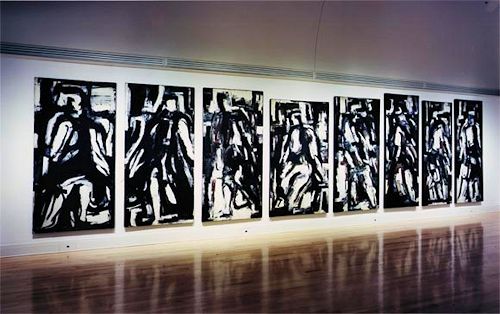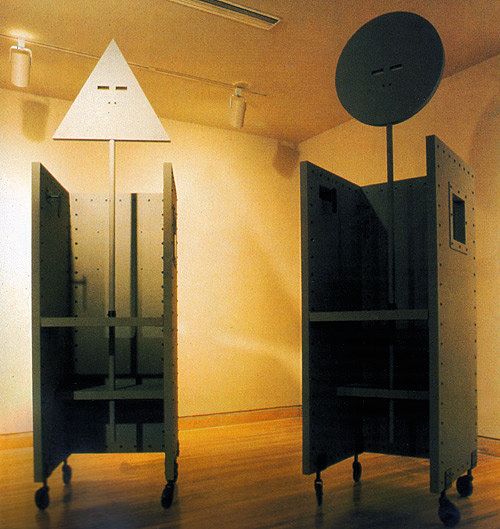Artforum 1984.11
John Hejduk ICA - Institute of Contemporary Art, Boston
John Hejduk’s New England Masque Anti Masque, 1984, was an eerie, brooding installation which transformed the windowless space of the second-floor gallery herewith connotations of tragedy and darkness. This was a collaborative effort involving over-life-sized architectural and sculptural constructions by Hejduk (who also conceived the work as a whole), Abstract Expressionist paintings from 1956 by Anthony Candido, a video tape by the poet David Shapiro featuring a dialogue between him and actress Connie Beckley, and atonal music by Morton Feldman. Although the components were ranged around the room’s periphery to create a central void, the work’s relentless sense of existential complexity, imminent chaos, and failed communion gave it a claustrophobic effect; Hejduk’s Devil’s Chairs, and his smaller, anthropomorphic models (“art,” “music,” and “security”), called forth associations of sadism, vulnerability, and despair. The power of the piece lay as much in its resonance—the way its visual and sonic afterimages reverberated after one had left the show—as in one’s concrete experience of it. Its immediate effect on me was an almost defensive dullness, and afterward came an echoing ache.
Since the late ’70s Hejduk has progressed from a Modernist formalism to a concern with the literary, symbolic, and narrative implications of structures in space. Essentially, he is a humanist, giving form in this installation to personal and social anguish. Hejduk eschews the cross-referenced decorative fillips of post-Modernism. Instead, he embraces a pure geometry: austerely enigmatic, the Devil’s Chairs are clean, three-sided wooden structures, each of which encases a stick figure whose head is cut in a cookie-cutter shape--a circle, a square, a triangle. Slit-eyed, painted a cool mat gray, with sides “stitched” by black screws, the figures nod to softness only through the addition of wooden wings, whose static nature still predominates. Yet even as their rigid casings imply armor, and the exaggerated scale of their polelike forms suggests Uccello’s lances and Sergei Eisenstein’s epic battle scenes, these emaciated bodies on casters (which make them manipulable by the viewer) allude in their fragility to helplessness, vulnerability, and the abdication of control. Hejduk’s installation presented a vision of the mutability and simultaneity of aggressor and victim, and of the opaque nature the two roles share.
Muteness hummed through Hejduk’s room, echoing in Feldman’s discordant. queasy music and in Shapiro’s and Beckley’s assertive video recitation. Underneath these murmurs one sensed a chasm of silence, an evocation of an elemental time which precedes language, music and poetry. Within this purer dimension sound generates form, and that which is unspeakable may rise to consciousness. Hejduk based his conception on the idea of order and disorder embedded within the structure of the Renaissance masque and antimasque; where the masque implied cohesion and hierarchy, the antimasque dramatized the world’s chaos, intruding with the inexorable reality of destruction.
Coming from the tradition of the decade after the last world war, this work was refreshing in that one was never in doubt as to its authenticity. The four artists, who share a twenty-year friendship, worked separately but in frequent contact until the piece was assembled--an uncertain venture, which coalesced. Their sensibilities both meshed and declared separateness, the multi-leveled themes unified by a shared preoccupation with evocation and negation, concreteness and dematerialization. The common ground was a sort of tenacious existential search for the perpetually elusive. Concurrent desires to be and to fuse could not be realized. The melancholy and longing of this darkling realm was broken by Shapiro’s occasional optimism in his conjuring of the male-female relationship, and by the underlying heroic nature of the entire endeavor.
--Nancy Stapen
|
| |

Anthony Candido 1956

Devil's Chairs
| |
|